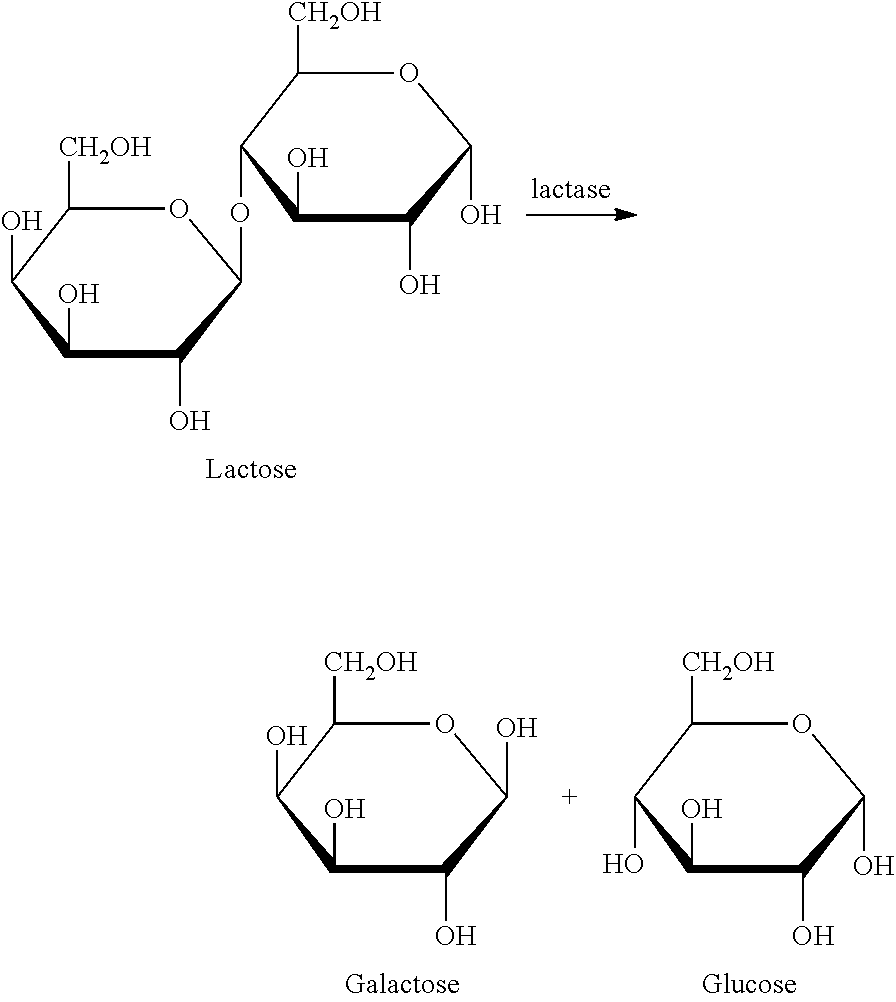Live biotherapeutics for the treatment of carbohydrate disorders
a biotherapeutic and live technology, applied in the field of live biotherapeutics, can solve the problems of limited capacity to metabolize a specific carbohydrate, onset of metabolic disorder, and wide range of toxic effects
- Summary
- Abstract
- Description
- Claims
- Application Information
AI Technical Summary
Benefits of technology
Problems solved by technology
Method used
Image
Examples
example 1
ation of Yeast Strains Capable of Degrading Galactose
[0076]A primary goal of the present invention was to develop yeast strains highly effective at metabolizing galactose. However, galactose-metabolizing yeasts are uncommon; yeasts typically prefer glucose, a carbohydrate source known to strongly suppress the expression of genes needed to metabolize other carbohydrates such as galactose (See Escalante-Chong et al., “Galactose metabolic genes in yeast respond to a ratio of galactose and glucose.” Proc Nat'l Acad Sci, USA 112:1636-41 (2015)). Wild type yeast strains may thus be prevented from utilizing any carbohydrates when glucose is present. Even if a yeast does have the capability to use other carbohydrate sources, it may occur late in the growth process, only after glucose has been completely depleted. Therefore, a particular type of galactose-metabolizing yeast was developed that degrades galactose in the presence of glucose. The present invention provides methods for adaptively...
example 2
Evolution Results in Superior Yeast Strains
[0080]Adaptive evolution—was applied to yeast strains, a method that can increase traits of a given strain owing to random mutations in the genome. Clones derived from parental strains that offer a phenotypic advantage are naturally selected when grown under selective pressure. Yeast can be subjected to adaptive evolution with changes that can be observed in a short time period because yeast grows rapidly as single cells in simple media, with the entire life cycle completed in culture similarly to bacteria.
[0081]Adaptive evolution was carried out by daily serial dilution of independent clonal populations of parental strains (See Çakar et al., “Evolutionary engineering of Saccharomyces cerevisiae for improved industrially important properties.” FEMS Yeast Res 12:171-82 (2011)). Parallel cultures were independently grown at 30° C. under agitation at 125 rpm in 15 mL CM medium in 50 mL vented tubes or 3 mL in 14 mL culture tubes supplemented w...
example 3
and Identification of Galactose-Degrading Strains
[0086]This study was focused on isolating yeast strains that would have the ability to degrade galactose. Yeasts were isolated from galactose-rich food samples such as dairy products and legumes. Various species were isolated by cultivating the samples in culture medium containing galactose at room temperature for a period of time of at least 2 days. The isolates were then subjected to adaptive evolution eventually followed by UV treatment to generate clones with superior galactose-detoxification performance. Taxonomy was assigned to isolates by a molecular approach based on targeted sequencing of Internal Transcribed Spacers (ITS).
[0087]Strains were isolated mainly from two sources: legumes (chickpeas, beans) and dairy product (kefir). For legumes, the seeds were collected into sterile flasks. For milk product, an aliquot of home-made kefir was utilized as inoculum. After cultivation for approximately 2 weeks at laboratory temperatur...
PUM
 Login to View More
Login to View More Abstract
Description
Claims
Application Information
 Login to View More
Login to View More - R&D Engineer
- R&D Manager
- IP Professional
- Industry Leading Data Capabilities
- Powerful AI technology
- Patent DNA Extraction
Browse by: Latest US Patents, China's latest patents, Technical Efficacy Thesaurus, Application Domain, Technology Topic, Popular Technical Reports.
© 2024 PatSnap. All rights reserved.Legal|Privacy policy|Modern Slavery Act Transparency Statement|Sitemap|About US| Contact US: help@patsnap.com









